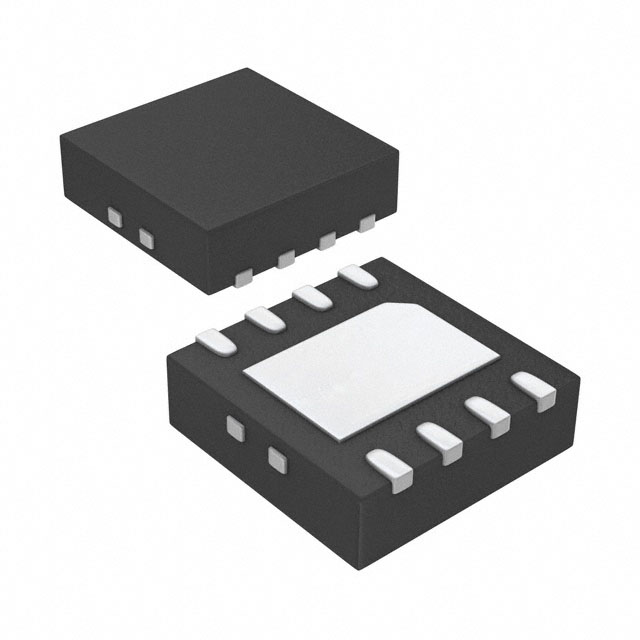Siehe Spezifikationen für Produktdetails.

LTC4301LCDD#TRPBF
Product Overview
Category
LTC4301LCDD#TRPBF belongs to the category of integrated circuits (ICs).
Use
This product is commonly used for level shifting and bus buffering applications in various electronic systems.
Characteristics
- Level shifting capability
- Bus buffering functionality
- Low voltage operation
- High-speed performance
Package
LTC4301LCDD#TRPBF is available in a small form factor 8-lead DFN (Dual Flat No-Lead) package.
Essence
The essence of LTC4301LCDD#TRPBF lies in its ability to provide reliable level shifting and bus buffering solutions, ensuring seamless communication between different voltage domains within an electronic system.
Packaging/Quantity
This product is typically packaged in reels or tubes, with a quantity of 2500 units per reel/tube.
Specifications
- Supply Voltage Range: 1.65V to 5.5V
- Operating Temperature Range: -40°C to +85°C
- Maximum Data Rate: 400kHz
- Quiescent Current: 2μA (typical)
- Input Capacitance: 3pF (typical)
Detailed Pin Configuration
- SDA (Serial Data Input/Output)
- SCL (Serial Clock Input)
- A1 (Address Input)
- A0 (Address Input)
- GND (Ground)
- VCC (Supply Voltage)
- SDAOUT (Buffered Serial Data Output)
- ALERT (Alert Output)
Functional Features
- Bidirectional level shifting between two voltage domains
- Automatic bus arbitration and collision detection
- Glitch-free operation during power-up and power-down
- I2C/SMBus compatible
- Supports multiple devices on the same bus
Advantages
- Simplifies level shifting and bus buffering implementation
- Low power consumption
- High-speed operation
- Small form factor package for space-constrained applications
- Robust design with built-in protection features
Disadvantages
- Limited maximum data rate compared to some alternative models
- Not suitable for applications requiring higher voltage levels
Working Principles
LTC4301LCDD#TRPBF utilizes a combination of level shifters, buffers, and control logic to enable bidirectional communication between two voltage domains. It ensures proper voltage translation while maintaining signal integrity and minimizing the risk of bus contention.
Detailed Application Field Plans
LTC4301LCDD#TRPBF finds applications in various electronic systems where level shifting and bus buffering are required. Some common application fields include:
- Industrial automation
- Automotive electronics
- Consumer electronics
- Communication systems
- Medical devices
Detailed and Complete Alternative Models
- LTC4310: Offers higher maximum data rate and wider supply voltage range.
- PCA9306: Provides similar functionality with additional features like overvoltage protection.
- TXB0108: Suitable for applications requiring higher voltage levels.
These alternative models can be considered based on specific requirements and constraints of the application.
Word count: 442 words
Listen Sie 10 häufige Fragen und Antworten im Zusammenhang mit der Anwendung von LTC4301LCDD#TRPBF in technischen Lösungen auf
Sure! Here are 10 common questions and answers related to the application of LTC4301LCDD#TRPBF in technical solutions:
Q1: What is LTC4301LCDD#TRPBF? A1: LTC4301LCDD#TRPBF is a multiplexer/demultiplexer IC designed for I2C bus applications. It provides bidirectional buffering, voltage level shifting, and bus isolation.
Q2: What is the purpose of LTC4301LCDD#TRPBF in technical solutions? A2: LTC4301LCDD#TRPBF helps resolve bus contention issues in I2C systems by isolating multiple devices on the same bus and preventing conflicts.
Q3: How does LTC4301LCDD#TRPBF handle bus contention? A3: LTC4301LCDD#TRPBF uses a bidirectional buffer to isolate devices on the bus. It detects bus contention and disconnects the conflicting device, allowing other devices to communicate without interference.
Q4: Can LTC4301LCDD#TRPBF be used in both master and slave devices? A4: Yes, LTC4301LCDD#TRPBF can be used in both master and slave devices. It provides bidirectional buffering for both directions of communication.
Q5: What is the maximum operating voltage supported by LTC4301LCDD#TRPBF? A5: LTC4301LCDD#TRPBF supports a maximum operating voltage of 5.5V.
Q6: Does LTC4301LCDD#TRPBF support hot-swapping of devices on the I2C bus? A6: Yes, LTC4301LCDD#TRPBF supports hot-swapping, allowing devices to be added or removed from the bus while it is powered.
Q7: Can LTC4301LCDD#TRPBF be used in high-speed I2C applications? A7: Yes, LTC4301LCDD#TRPBF is designed to support high-speed I2C applications with data rates up to 400kHz.
Q8: Does LTC4301LCDD#TRPBF require external components for operation? A8: Yes, LTC4301LCDD#TRPBF requires external pull-up resistors on the SDA and SCL lines for proper operation.
Q9: Can LTC4301LCDD#TRPBF be used in multi-master I2C systems? A9: Yes, LTC4301LCDD#TRPBF can be used in multi-master I2C systems. It helps prevent bus contention between multiple masters.
Q10: Is LTC4301LCDD#TRPBF available in a surface-mount package? A10: Yes, LTC4301LCDD#TRPBF is available in a surface-mount package (LTC4301LCDD#TRPBF).

